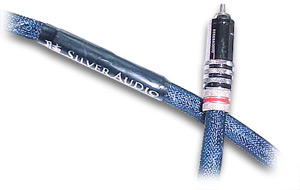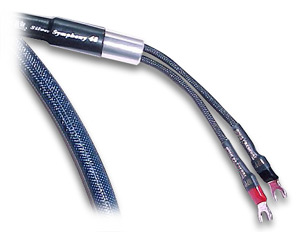![[SoundStage!]](../titles/sslogo3.gif) Home
Audio Home
Audio Equipment Review |
|||||||||||||||||
April 2002 Silver Audio Jetstream Interconnects and Silver Symphony 48 Speaker Cablesby Andrew Chasin
It’s been a few years since I last reviewed a product from Silver Audio. Back then, the company was known as D Lin Audio and had just broken into the high-end cable game with an interconnect called the Silver Bullets 4.0. Having heard Max Kreifeldt's over-achieving Silver Bullets and spent time listening to his thoughts on cable design, I came to admire his emphasis on sound engineering principles (low capacitance and self-inductance, for example), rather than the sort of pseudo-scientific mumbo-jumbo spouted by many so-called cable designers. My positive experience with the Silver Bullets had me jumping at the chance to review Kreifeldt’s Silver Breeze phono cable, which I found to be an excellent example of the genre that I would still use if not for my Graham tonearm’s need for a thinner, more flexible cable with DIN termination. Early iterations of the Silver Bullets interconnects (whose design was based on Kimber’s popular KCAG) looked rather unremarkable, but they sounded much better than they had any right to at their asking price: less than $200 USD per meter pair, including some of the tightest-gripping silver-plated Cardas RCA connectors I’ve ever used. Later versions traded in their DIY appearance for a more polished look, including an attractive exterior sheathing material and high-quality locking RCA connectors from WBT. With an eye on the upscale cable market but its foot still planted firmly in the value-for-dollar camp, Silver Audio introduced a succession of more sophisticated cable designs in its so-called Baseline series, the most recent of which are the top-of-the-line Jetstream interconnects and Silver Symphony 48 loudspeaker cables. The Jetstream interconnects ($550 per meter pair) are a typical Silver Audio design: a cable comprised of small-diameter, solid-core, Teflon-insulated silver conductors wound using a geometry that results in low capacitance and self-inductance (Silver Audio is one of few cable manufacturers that publishes capacitance and inductance specifications for its cables). The interconnects are terminated with connectors of the highest quality, in this case the locking WBT 0108 RCA connector (balanced XLR connectors are also available at no extra cost).
The Silver Symphony 48 ($1700 per eight-foot pair) has been a mainstay of the Silver Audio line for a few years, but it has continued to evolve. The current design incorporates 48 Teflon-insulated solid-core silver conductors (over 12 ounces of silver are used in each eight-foot pair!) wound, as with the Jetstream interconnects, in such a way as to greatly reduce both capacitance and inductance. The Silver Symphony 48 is now being terminated with Silver Audio’s High Pressure Fusion technique, which fuses the cable’s silver conductors directly to the body of the terminating spade connector under 12 tons of pressure, eliminating the need for the typical solder or crimp joints that can result in signal loss. The spade, manufactured by Cardas, is milled from a solid block of copper and then silver plated by Silver Audio. With the Jetstream and latest incarnation of Silver Symphony 48, Silver Audio has jettisoned all of the DIY look of its earlier products. The fit and finish of both review samples were exemplary. Review system Listening was done in the context of my usual reference system: VPI Aries turntable/SDS Speed Controller/Graham 2.0 tonearm/Transfiguration Spirit phono cartridge, Audible Illusions Modulus 3a preamplifier with John Curl-designed MC stage, Simaudio Moon W-5 power amplifier, Harmonic Technology Pro-Silway interconnects and Pro-9 Plus loudspeaker cables. I was fortunate enough to have a wide variety of loudspeakers on hand, including Anthony Gallo Acoustics Nucleus Solo, Audio Physic Tempo IIIi, Silverline La Folia, and Magnepan MG3.6/R, with which to assess the Silver Symphony 48 loudspeaker cables. For a product category that is typically highly system dependent, the Silver Audio cables exhibited surprisingly consistent results with all of the gear I used. Unlike cables from other manufacturers, the sound of the Silver Audio cables changed little over the review period, so prospective purchasers should be able to hear the full measure of these products after relatively little break-in time. Listening Swapping cables rarely causes the same level of sonic transformation in my system as switching phono cartridges or loudspeakers (the mechanical side of audio reproduction still seems to exhibit the most sonic variability), and replacing my reference Harmonic Technology cables with the Silver Audio products was no exception. While there were noticeable differences, they were hardly of the jaw-dropping variety. Regardless of which loudspeakers I happened to be listening to at the moment, my overriding impression of the Silver Audio Jetstreams and Silver Symphony 48s was one of crystalline clarity, a vanishingly low level of grain in the upper midrange and treble, and a high level of transparency across the audio band. As with the budget Silver Bullets 4.0s I reviewed a few years back, neither the Jetstream nor Silver Symphony exhibited any hardness or glare in the high frequencies, a quality that has, in some circles, come to be associated with cables employing silver or silver-coated-copper conductors. Listening to Ella Fitzgerald’s Ella Swings Lightly [Verve MGVS-6019, LP], I was struck by the purity of the muted trumpets and saxophones used in Marty Paich’s brilliant orchestration, with no sense of the unnatural edge imparted by lesser cables. The sound of well-recorded strings, such as those on Aaron Copland’s Appalachian Spring Suite [RCA LSC-2401, LP], was equally silky and seductive, although the more wiry tone of period instruments, such as those heard on The Academy of St. Martin-in-the-Field’s traversal of Bach’s Concertos for Three Violins [Argo ZRG 820, LP] was not rounded over by the Silver Audio cables. The middle frequencies are where most components make it or break it, and the Silver Audio cables more than made the grade here, especially when coupled with the wonderfully uncolored Magnepan MG3.6/R (full review forthcoming). I never grew tired of listening to the likes of Janis Ian, Holly Cole, Ella Fitzgerald and Billie Holiday while the Silver Audio cables were in the system, their smooth, grain-free nature making the most of this eclectic mix of pop and jazz divas. Although I noted no real aberrations in the Silver Audio’s tonal balance, there was a sense of coolness (not to be confused with brightness) in their overall presentation that seemed to be the result of a slight lack of energy in the mid- to lower bass. This manifested itself in a loss of warmth and weight on some recordings, most notably on full-scale orchestral works, and some jazz and pop recordings with a significant amount of energy in this region. As a result, bowed and plucked bass, as well as the lower toms of the drum kit and the lower registers of the piano, seemed to lack the last ounce of weight that was more convincingly communicated by the Harmonic Technology Pro-Silway and Pro-9 Plus cables. Michel Petrucciani’s left-hand piano lines on Power of Three [Blue Note BTC 85133, LP], for example, didn’t have quite the body to which I’m accustomed to hearing, nor did the sound of Scott Lafaro’s bass on Bill Evans’ Waltz for Debbie [Analogue Productions APJ 009, LP]. I don’t want to harp on this point too long because, in absolute terms, the weight and body heard through the Silver Audio cables was rather good. Only in comparison to meatier cables, like those from Harmonic Technology, did the Silver Audio cables fall a bit short. In comparison to the Silver Bullets 4.0s that I reviewed way back when, the Jetstream is a sonic step up, although for just over twice the price. Whether its improvements (greater transparency, more extension at the frequency extremes and better overall resolution) are worth the added cost in the context of your system and pocketbook is up to you, although the Jetstreams are certainly worth a listen if you’re looking to upgrade to interconnects in the $500-$600 price range. Comparing the older generation Silver Symphony 48 loudspeaker cables to the current model was less conclusive. In terms of fit and finish, the latest generation has it all over the older version, and the HPF termination is, at the very least, a theoretical improvement and one that may provide greater long-term reliability (although I haven’t heard of too many cable solder joints going bad). Owners of earlier versions of the Silver Symphony 48 need not worry that they’re missing much, although the HPF termination is a rather interesting option. Conclusion Overall, I was most impressed with the Silver Audio Jetstream interconnects and Silver Symphony 48 loudspeaker cables. They bring to the table a wonderfully grain-free presentation, smooth, detailed treble, uncolored midrange, excellent resolution, and a well-balanced sound that was consistent across a wide variety of associated components. While I felt they leaned toward the cool side of things and lacked the heft and warmth of my reference Harmonic Technology cables, there will be systems to which they will be a perfect complement. (As with all audio products, a thorough audition in your own system is mandatory before purchase.) It’s difficult to avoid the inevitable comparison between the Silver Audio cables and my current reference, the Harmonic Technology Pro-Silway interconnect and Pro-9 Plus loudspeaker cable. Although the Silver Audio cables might just edge out the Harmonic Technology cables in terms of upper-frequency purity, the weightier presentation of the single crystal cables is a better fit for my current system and tastes. At their price point, both cables are near the cream of the crop and would be at home in a wide variety of high-resolution systems. Give them both a listen and pick your poison. ...Andrew Chasin
|
|||||||||||||||||
|
|||||||||||||||||
![[SoundStage!]](../titles/sslogo3.gif) All
Contents All
ContentsCopyright © 2002 SoundStage! All Rights Reserved |

